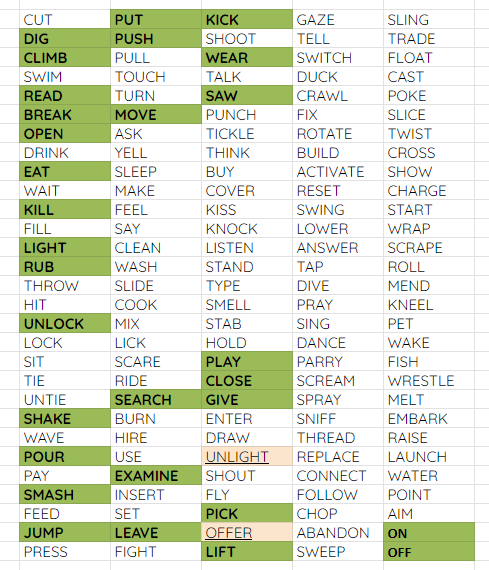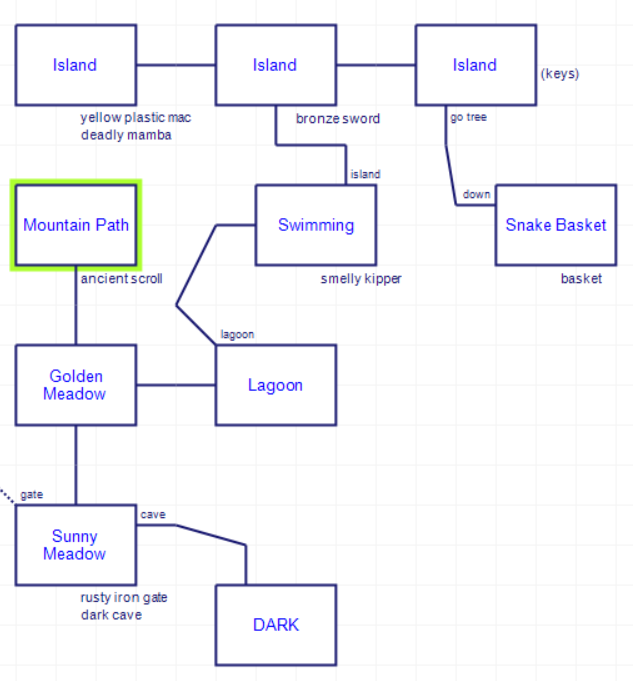I’ve finished the game, and this continues directly from my last post.

British schoolchildren (Andy Stoneman, Luke Youll, John Shaw, David Graham, Steven Iveson) using a Video Genie, from the Mirror, 1981.
I left off on the edge of a cliff where the game hinted I needed to use a “wishing staff” but I was unable to do so. The game needs, admittedly logically, the verb WISH. I am still unclear what action is really being taken by the player. I can concretely visualize “wave” or “shake” or even — to cause the wishing staff to shrink back to a normal staff — the verb “rub”. Does wish involve saying some magic phrase, or is it reflective of an internal state of mind? This is not purely theoretical: I know from experience I have a harder time summoning up such verbs when they occur.

The game is also finicky about how the item is held. You must be holding the staff to use wish (and then the game will have you drop it); you must have the item dropped to be able to use “rub” and undo the wish.
Crossing over reveals a “dynamite shack”. Despite visible threats to the contrary it will not tip over no matter how hard you try to whack at it.

The dynamite turns out to be what we need to break into the glass dome, but we need to be able to light the fuse on it first with a match (hence needing both a match, and a thing to strike the match on to light it). The switch either causes some pipes to make sounds (if you type OFF) or water to start running (with ON). I tried each and then running all around the map until I could find a result. With the water ON:

Just in case you want to see the result without the jacket on:

“scoulded most heinus” is a terrific one for the collection.
I was stuck a long time here and ended up finally prowling through source code. I didn’t hit much enlightenment other than finding there were multiple “cave” rooms. My prior attempts at poking in the dark cave led me to breaking my neck. Here is when I needed to take a leap of insight/faith.
We have seen many, many different methods now of coping with darkness. Darkness will randomly kill you if you are in it long enough (Crowther/Woods Adventure); darkness will kill you upon one step (Zork); darkness will kill you if you go “down” while it is dark (Ferret); darkness is safe as long as you don’t run into a wall (Scott Adams). Given this was designated as an Adams tribute, I should have figured it would be the last case, but I was originally treating the darkness more like Zork.
The other thing is: “exploring” in the dark in the Scott Adams games was always a sort of hack. In Savage Island, Part 1, you could technically skip solving a puzzle via tediously mapping through the dark, but it was obviously not an “intended” solution, so here, I was treating the darkness in a similar way. This was a mistake.
You have to feel through the darkness in this game.

This means, essentially, you have to map your way through with random fatal falls. There is the unspoken rule in some games that this level of randomness means you have reached “brute force” and need to lean off, but it doesn’t take long here if you start mapping to find some “strange oozy mud” which glows in the dark.

Here’s the map I made, including the “stubs” I added when I fell in the dark:

To the south you can pick up a match (as long as you’ve swapped the geyser from below-ground to above-ground) although you still need a way of lighting it. To get that you need to first get by a “large rock” in the cave. You are explicitly given the hint to try to “prise” it but I was having no luck. I realized the fact I could undo the wishing operation meant the staff was a likely candidate tool, and indeed:

The next step uses an object I only mentioned incidentally: a bone that’s sitting at the scary altar from last time. Past the rock is a valley of bones, so I tried (based on the game’s text) to return the bone back home.

The empty match box has the standard-issue friction surface on the side, which is sufficient to light the match. So we can take match, box, and dynamite back to the glass dome to win the game. (Mind you, this still took me a while, I tried commands like STRIKE MATCH and the like which were not understood; the game wants you to skip all the implicit action and go straight to BLOW DOME.)


Go bowling forever, I guess.
I’ve been wondering, from the author’s note in my last post about trying to publish the game, who he tried to publish with. The TRS-80 was not prolific in the UK; if you saw one, it was often the cheaper clone system Video Genie (seen at the top of this post) instead of the proper Radio Shack system. Even given the clone presence, there wasn’t a giant stack of publishers to choose from like with the ZX-80/81/Spectrum; really the most likely possibility is Molimerx, which published the early Howarth work and also Temple of Bast. I wouldn’t say they were overwhelmed with adventures, though. My guess is if Paul Standen accurately reported that they wanted “arcade games” because of having too many adventures, it was rather that Golden Apple was not quite at the same standard as the other games. Or maybe the swearing and tone weren’t respectable-commercial enough. When in the dark you are told you “can’t see shit”; this is not the sort of message that would appear in any “respectable” adventures until, maybe, the late 90s? (I’m thinking Little Blue Men by Michael Gentry of Anchorhead fame, and Chicks Dig Jerks by Robb Sherwin who went on to make games like Cryptozookeeper.)
This game isn’t interesting as a grand moment in game design (although the philosophical handling of darkness was accidentally of note); it does give another good data point of what a schoolchild’s real game-writing was like, with the attitude of the “Adventure narrator” cranked higher in intensity and lower in maturity.

Just a joke bit.
Coming up next: A sequel, where we must battle against Hitler one last time.

















